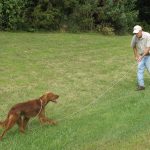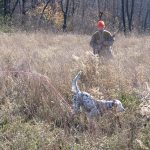Birds and Training
Pointing Dog Pointers
by Bob and Jody Iler

Here in the Midwest, pigeons, quail, chukars, and pheasants are fairly easy to attain; one or another of them will work at varying stages in your pup’s development. Gamebird breeding farms, hobby bird breeders, and game preserves are all good sources of acquiring birds for training.
The common pigeon is likely the most economical and possibly the easiest to attain if you are acquainted with a few farmers who would like to lower the pigeon population in their sheds and barns. For many years we’ve caught pigeons at night using flashlight, net and burlap sack, helping to supplement our pigeon pen stock. Sometimes we would purchase pairs of pigeons at bird fairs as well.
Pigeon coops can be built and located unobtrusively in neighborhood backyards as well as country homes. If you have some good homing pigeons and only use blank guns in training with them, they will recall to their pens, once well-acclimated, and you’ll enjoy many seasons of use with them. Years ago, Bob’s father had several runs for his shorthairs attached to the rear of his garage in Elmhurst, Illinois, and also had a small pigeon coop with homing pigeons used for training. His foundation pair, “Fast Delivery Boy” and “Fast Delivery Girl,” would often beat Bob’s dad and the dogs home after a session of training in outlying area fields!
Likewise, quail can be bought at breeding farms and game preserves and kept in a relatively small Johnny house for use in training. Quail, like pigeons, will recall readily back to the pen, as long as other birds remain in the pen to call them back. Also available are small, portable wire recall cages that can be taken with you to training areas. Several birds can be left in the portable cage while others are used for training, and the birds in the field will usually recall back to the portable pen.

Chukars and pheasants can also be purchased like quail, through breeders and game preserves. Having many young pheasants in a smaller enclosure is not a good idea, as they will peck each other and usually require blinders to keep from doing so. Keeping a cock bird and several hens for training use works well. Chukars also do well in bird pens. Normally, both pheasants and chukars will not recall to the pens after training use in the field, so these birds aren’t as practical for the novice trainer to keep and use.
Now, let’s take a look at what birds to use, when, and why.
Quail and pigeons are good choices for most young pups. We like to start with quail, as they are the smallest and can be easily hobbled for gentle introduction to birds with very young pups. As the pups become bolder, we unhobble the quail, releasing them to run and fly. This will excite the pups into chasing them and generate that first spark of enthusiasm that will fan into a lifelong love of birds. Quail have a gamey scent that pups, once introduced to them, will not forget.
Many great bird dogs have been started out on the good old common pigeon. For many pointing dog enthusiasts new to the game, pigeons are the most easily available. It’s important to remember, though, that pigeons will fly up and away with a flapping of wings that can scare or intimidate a young pup first being introduced to birds. Often the pup may startle, back up a bit, and simply watch the pigeon fly away. Some birdy types will take off after the flyaway pigeons with nary a look back, but we’ve found that with quail introduction first, we make sure that a shy pup gets off on the right foot. Pigeons, too, can be hobbled during bird introduction. But the key difference is that they will usually fly, once unhobbled, up high and far away. Quail, on the other hand, will often come back down, to be found again by the young pupil.
We once had a special shorthair named Ranger who refused to work pigeons. For him, it was as though they did not exist. Put a pigeon out in the field, and Ranger, right from the start, ignored it. He lit up for gamebirds, but it was obvious that pigeons were beneath him! You, too, may end up owning a pup like Ranger, who knows that he’s really meant to hunt and point gamebirds, not pigeons, and will let you know this right from the get go. If you have this particular pup, remember our Ranger, and make the effort to introduce your pup to quail. If he has good genetics, you won’t be disappointed!

Finally, we’ll progress to pheasants as the last step in our bird training program, but even then, we’ll use hen pheasants first. They don’t cackle and won’t spur a pup if crippled. They’re also smaller and easier for the pup to pick up, if the dog is a natural retriever. The disadvantage with pheasants and young dogs is that the pheasants will often run, making it more difficult for the inexperienced dog to find and point.
Wild birds, of course, will put the icing on the cake for your dog once her bird training has progressed to that point. Trying to develop your pup on wild birds can be difficult. If she’s not been properly introduced to birds, wild birds can be a strange, often frightening experience. Also, hunting a pup all morning on a cold fall day, without finding a single bird, will do nothing to bring out the bird dog fire in her. You can’t predict what wild birds will do, where they are, or how your inexperienced pup will react.
Birds, birds, birds—but used in the proper sequence, with gentle introduction, and sensible progression—will develop your pointing dog into the one you’ve dreamed of!
Next month, we’ll talk about the many different ways to plant those birds.
Pointing Dog Pointers features monthly training tips by Bob and Jody Iler, who own Green Valley Kennels in Dubuque, Iowa. Bob and Jody have trained pointing dogs for over 35 years and have written many articles for The Pointing Dog Journal.





